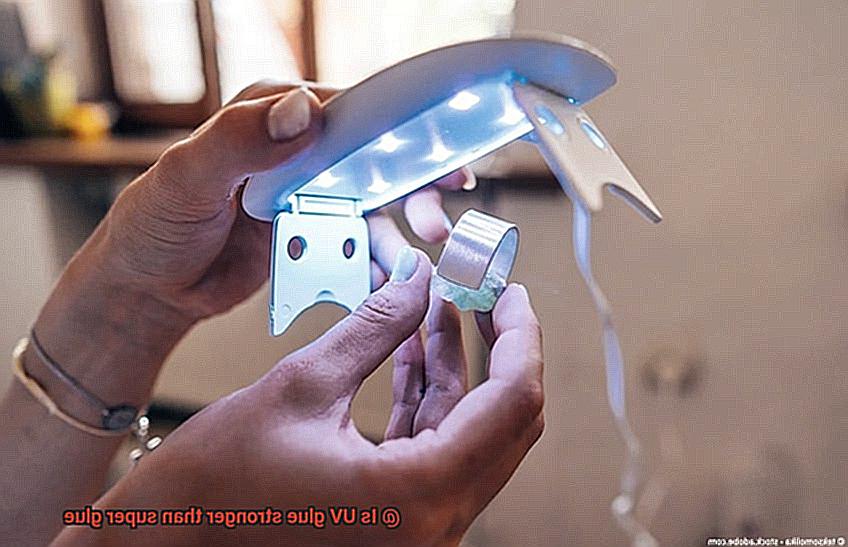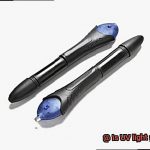It’s time to settle this adhesive duel once and for all. We all know super glue has been our go-to for ages, holding together everything from broken ceramics to wonky picture frames. But hold onto your hats because there’s a new kid on the block – UV glue, the instant adhesive that claims to be even stronger and tougher.
In this blog post, we’re diving headfirst into the age-old question that keeps DIY enthusiasts up at night: Is UV glue really stronger than super glue? We’ll dig deep into the nitty-gritty details of these adhesives’ properties, applications, and raw power to help you make an informed decision when it comes to sticking stuff together.
So grab your magnifying glass (okay, maybe not that extreme) and get ready for an adhesive adventure like no other. It’s time to find out which glue will reign supreme in the battle of strength and durability.
What is UV Glue?
Contents
- 1 What is UV Glue?
- 2 What is Super Glue?
- 3 Strength Comparison between UV Glue and Super Glue
- 4 Factors Affecting Bond Strength of UV Glue
- 5 Applications of UV Glue
- 6 Applications of Super Glue
- 7 Other Considerations for Choosing the Right Adhesive
- 8 Advantages and Disadvantages of Both Types of Adhesives
- 9 Conclusion
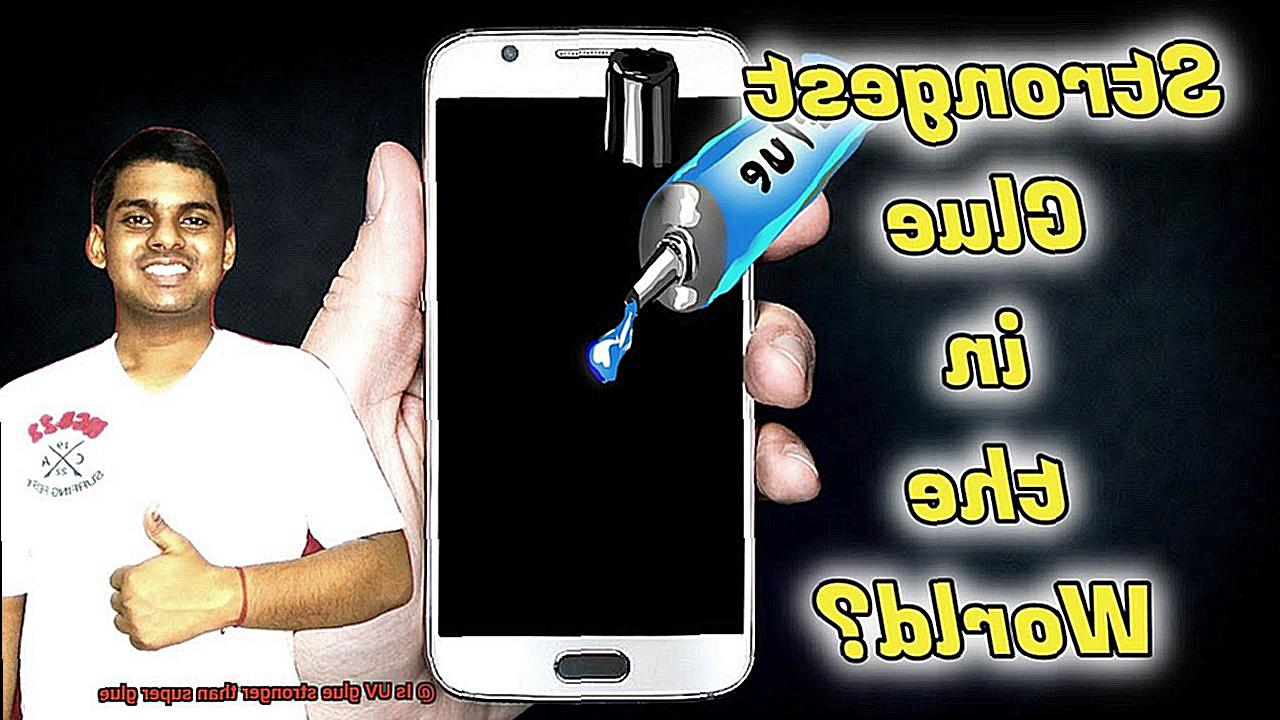
Step into the world of adhesives and discover the extraordinary capabilities of UV glue. This innovative bonding solution stands out with its ability to rapidly cure and create a robust bond under the influence of ultraviolet light. Join us as we delve into the unique properties and advantages of UV glue, comparing it to its popular counterpart, super glue, to determine its superior strength.
Properties and Advantages:
- Swift Curing Time: Unlike traditional adhesives that demand hours or days to solidify, UV glue hardens in an instant when exposed to UV light. This unparalleled speed enhances productivity and efficiency in manufacturing processes.
- Unyielding Strength: Once cured, UV glue creates an unbreakable bond capable of withstanding substantial stress and heavy loads. Its remarkable adherence to materials such as glass, metal, plastic, ceramics, and wood makes it ideal for a wide range of applications.
- Spectacular Transparency: When applied to transparent materials like glass or acrylic, UV glue produces an invisible bond. The result is a seamless and aesthetically pleasing finish that satisfies even the most discerning eye.
- Resilience against Environmental Factors: UV glue demonstrates outstanding resistance to temperature fluctuations, moisture, chemicals, and aging. It remains strong and intact even amidst harsh conditions, making it suitable for both indoor and outdoor applications.
Comparison with Super Glue:
While both UV glue and super glue are popular adhesives, UV glue generally surpasses super glue in terms of strength. The secret lies in its ability to form a chemical bond with the materials it is applied to, resulting in an unbreakable and long-lasting connection. In contrast, super glue relies on physical adhesion, which may prove less sturdy in certain scenarios.
What is Super Glue?
Prepare to be amazed by the incredible powers of Super Glue. This fast-acting adhesive, also known as cyanoacrylate adhesive, is the superhero of the glue world. It can fix broken items and join different materials together in a flash. With its exceptional bonding strength and lightning-fast drying time, it’s no wonder Super Glue is a favorite in both households and industries.
So what makes Super Glue so super? Let’s start with its secret ingredient: cyanoacrylate. This clear liquid has a low viscosity and when it comes into contact with moisture, it undergoes a magical chemical reaction that causes it to polymerize and form strong bonds. And when we say strong, we mean it. Super Glue can bond various materials like metal, plastic, rubber, ceramics, and even some types of wood. It’s like having a superhero on your side for all your repair needs.
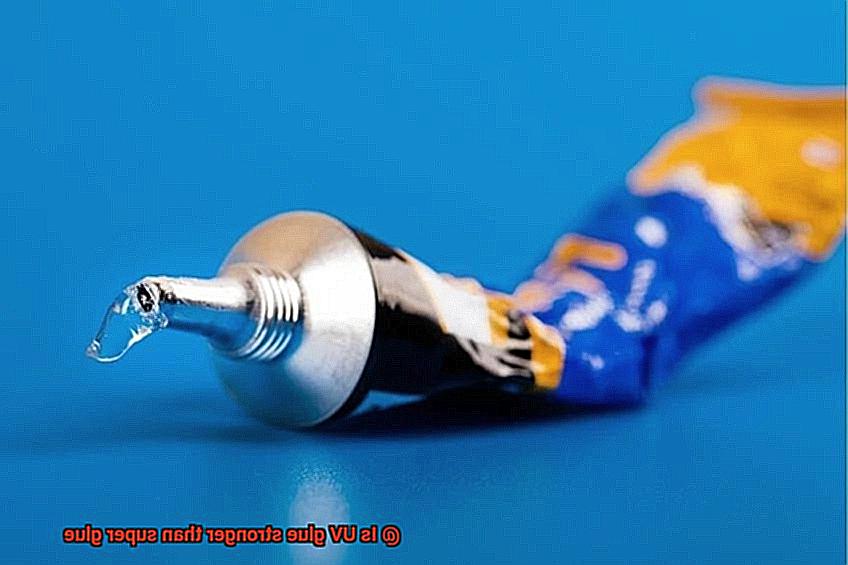
One of the coolest things about Super Glue is its ability to create a tight bond between surfaces. It fills in gaps and forms a connection so strong that it can withstand stress and impact. Plus, it’s resistant to temperature changes, making it perfect for both indoor and outdoor use. Talk about versatility.
But before you go running off to save the day with Super Glue, there are a few things to keep in mind. While it can work wonders on many materials, it may not be suitable for all. Porous surfaces like fabric or paper may not bond well with Super Glue due to their ability to absorb moisture. In these cases, alternative adhesives may be more appropriate.
Super Glue comes in different forms like liquid or gel, giving you the flexibility to choose what works best for your needs. And if you have a specific project in mind, there are even specialized versions of Super Glue available for bonding glass or metal. It’s like having a whole team of superheroes at your disposal.
Strength Comparison between UV Glue and Super Glue
In the world of adhesives, two heavyweights reign supreme: UV glue and super glue. While both have their own unique strengths, determining which one is the ultimate champion requires a closer examination. Let’s delve into the realm of glues and discover the differences in their strength.
Super Glue’s Herculean Bonds:
Let’s begin with the fan-favorite, super glue. This adhesive is renowned for its exceptional bonding strength, creating robust and enduring bonds across a range of materials including metal, plastic, wood, and ceramics. Its tight grip is notoriously difficult to break. In need of a quick fix? Super glue is your reliable superhero.
UV Glue’s Transparent Might:
Now, let’s shed light on UV glue. While it may not match the raw power of super glue, this adhesive offers a different type of strength. UV glue possesses the ability to bond transparent materials without leaving any visible residue or marks. It is perfect for applications such as glass bonding or jewelry making where aesthetics are of utmost importance.
Versatility Showdown:
Both UV glue and super glue showcase their versatility in the ring. Super glue can be used on a wide range of materials, including porous surfaces, and forms a bond within seconds. On the other hand, UV glue requires exposure to UV light for curing, which limits its application to transparent or light-permeable materials.
Environmental Resistance:
Super glue flexes its muscles when it comes to withstanding heat and chemicals. This adhesive can endure high temperatures and harsh chemical environments with ease. However, UV glue may not offer the same level of resistance and can degrade or weaken when exposed to certain chemicals or extreme temperatures.
The Final Verdict:
While super glue steals the show with its exceptional bonding strength, UV glue showcases its prowess in applications where transparency and aesthetics are paramount. Ultimately, choosing between UV glue and super glue depends on the specific project requirements and the materials at hand. It is always advisable to conduct a small-scale test to ensure the desired strength and durability before committing to a full bond.
Factors Affecting Bond Strength of UV Glue
The bond strength of UV glue can be influenced by several factors that are essential to understand to ensure successful adhesive joints. These factors include the type of substrates, surface preparation, cure time and intensity, thickness of the glue line, environmental conditions, and mechanical stress.
Different materials have different surface properties that can impact adhesion. Smooth and non-porous materials like glass and metals typically provide stronger bonds with UV glue. However, porous and low-surface-energy materials like plastics may require additional surface treatments or primers to enhance bond strength.
Proper surface preparation is crucial for achieving strong bonds. Surfaces should be cleaned thoroughly to remove any contaminants that can hinder adhesion. This may involve solvent wiping, sanding, or using surface activators to promote adhesion. Some substrates may even require roughened surfaces or the use of adhesion promoters for optimal bond strength.
UV glue relies on ultraviolet light for curing, so it is important to follow the manufacturer’s recommendations regarding the required curing time and intensity. Insufficient exposure to UV light can result in incomplete curing, leading to weaker bonds.
The thickness of the glue line is also critical. A thicker layer of UV glue can lead to weaker bonds due to increased stress concentrations and reduced contact area between the materials. It is best to keep the glue line thickness within specific ranges provided by the manufacturer.
Environmental conditions can impact bond strength as well. Extreme temperatures can cause expansion or contraction of the substrates, affecting bond integrity. High humidity levels can also impact the curing process and result in weaker bonds. It is important to consider the recommended temperature and humidity ranges for optimal bond strength.
Mechanical stress plays a role in bond strength as well. Different applications may require different levels of bond strength depending on the expected mechanical stress. If significant mechanical stress is anticipated, additional reinforcements or mechanical fasteners may be necessary.
Applications of UV Glue
Say goodbye to the days of waiting for glue to dry because UV glue is here to save the day. This magical adhesive, also known as ultraviolet curing adhesive, is a game-changer when it comes to bonding various materials. Let’s dive into the fascinating world of UV glue and explore its applications in different industries.
First up, we have the electronics industry, where time is money. UV glue is a superhero when it comes to bonding components like circuit boards, connectors, and wires. Its instant curing property means that production time is drastically reduced, making it a favorite among manufacturers.
Next, let’s talk about the medical field. UV glue plays a crucial role in bonding medical devices such as catheters, syringes, and surgical instruments. The strong bond provided by UV glue ensures that these devices can withstand the rigors of medical procedures, keeping patients safe and secure.
Now, let’s shift gears to the automotive industry. UV glue is a champion when it comes to bonding parts made of glass, metal, and plastic. It can handle vibrations, temperature changes, and exposure to chemicals without breaking a sweat. Talk about strength under pressure.
Woodworking enthusiasts will love UV glue for its ability to bond wooden furniture and fixtures. It can withstand the stress and strain exerted on furniture pieces, ensuring they stay intact for years to come. Plus, it leaves no visible residue or marks, giving your creations a professional finish.
Glass artists will rejoice at the sight of UV glue. It allows seamless bonding of glass panels without affecting their aesthetics. Say goodbye to unsightly marks ruining your masterpiece.
But wait, there’s more. UV glue also shines in the jewelry industry, where it securely bonds gemstones to their settings. And for all you arts and crafts lovers out there, UV glue is perfect for all your crafting projects that require strong adhesion.
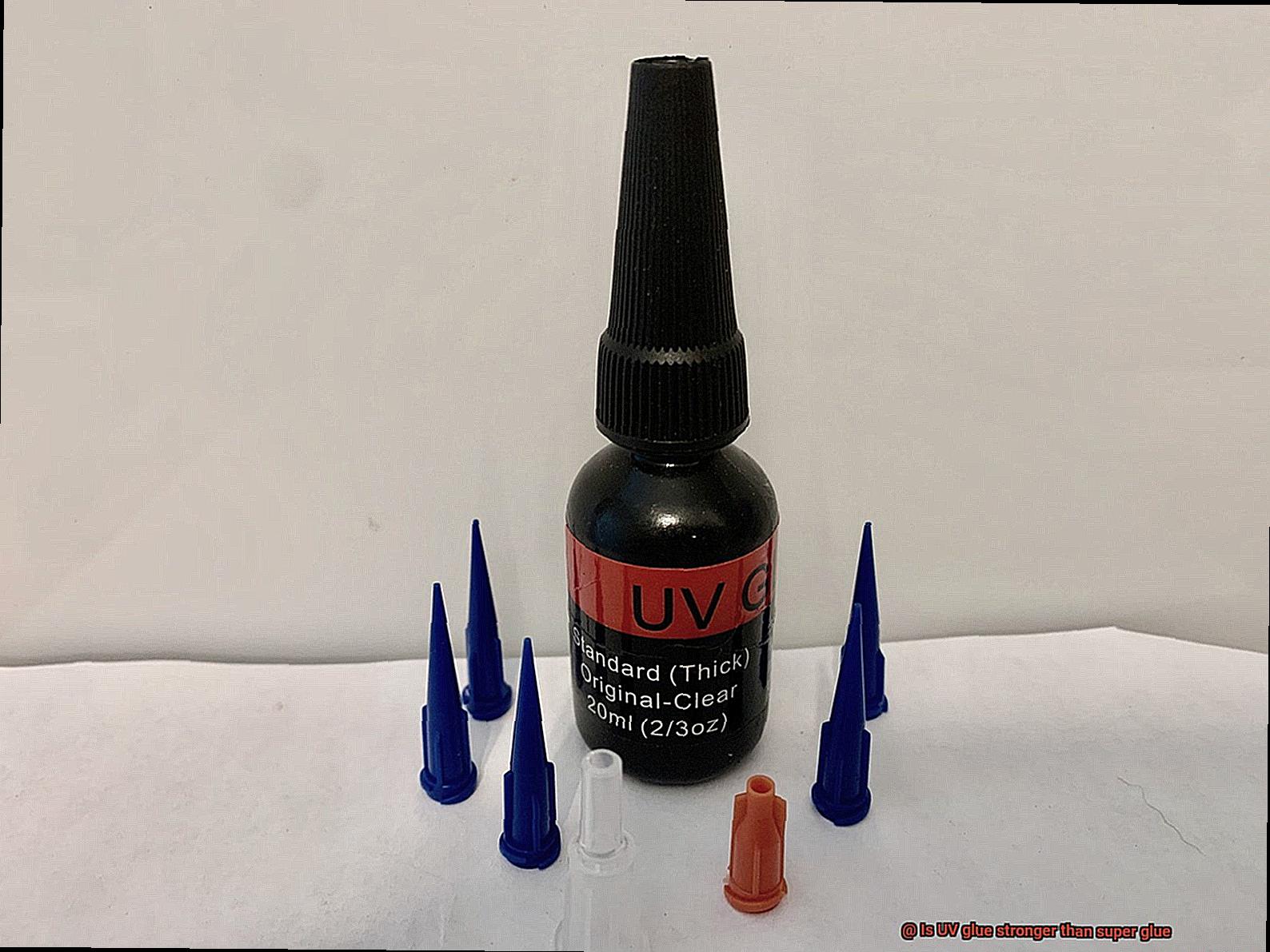
Applications of Super Glue
Super glue, also known as cyanoacrylate adhesive, is a true superhero of the adhesive world. Its versatility and quick-drying nature have made it an essential tool in a wide range of applications. Let’s explore the exciting world of super glue and discover its many uses.
First and foremost, super glue is a go-to solution for household repairs. It can fix broken ceramics, glass, plastic, and even wood with ease. From mending your favorite coffee mug to repairing a cracked vase, super glue is always ready to save the day.
Crafters and DIY enthusiasts also adore super glue for its ability to bond different materials together. Whether you’re working with metal, fabric, leather, or paper, super glue is the ultimate adhesive for various art and craft projects. It opens up a world of possibilities for creating stunning jewelry, unique sculptures, and beautiful handmade cards.
But did you know that super glue has also found its place in the medical field? It can be used to close small wounds or cuts when traditional stitches are not necessary. The waterproof seal it creates helps prevent infection and promotes faster healing. So the next time you have a minor cut that needs closing, reach for super glue.
The automotive industry relies on super glue for small repairs as well. It can fix cracks or chips in windshields and headlights, thanks to its strong adhesive properties that can withstand vibrations and extreme temperatures. So if you notice a small crack in your windshield, don’t panic – just grab some super glue and save yourself a trip to the auto shop.
Super glue even plays a vital role in the world of electronics. It can secure loose wires or components on circuit boards, ensuring a secure bond that can withstand the rigors of electronic devices. Whether you’re repairing a broken smartphone or building your own computer, super glue will keep everything in place.
Woodworking enthusiasts also appreciate super glue for its ability to bond joints and hold pieces of wood together during construction or repair work. However, it’s important to note that super glue may not be suitable for all woodworking applications, as it can become brittle over time.
In the world of jewelry making, super glue is a true lifesaver. It can attach gemstones or beads to various types of jewelry settings, providing a strong bond in a short amount of time. With the help of super glue, you can create stunning necklaces, earrings, and bracelets that will stand the test of time.
Even the dental field has embraced the power of super glue. It can be used for temporary dental repairs, such as fixing a loose crown or reattaching a broken denture. However, it’s crucial to consult a dentist for proper guidance and to ensure that it is safe to use in specific dental situations.
Last but certainly not least, super glue has made its mark in crime scene investigations. Forensic experts use it to lift fingerprints from non-porous surfaces and preserve them for analysis. Its adhesive properties allow for easy collection and retention of crucial evidence.
Other Considerations for Choosing the Right Adhesive
When it comes to choosing the right adhesive for your project, there’s more to consider than just the strength comparison between UV glue and super glue. Sure, strength is important, but you also need to think about the materials you’re working with, the application method, setting time, flexibility, durability, environmental resistance, and cost.
Let’s start with materials. Different adhesives are better suited for specific materials. Some may adhere well to metal but not to plastic, while others may be perfect for wood but not for glass. It’s important to understand the compatibility of the adhesive with the materials you’re bonding to ensure a strong and long-lasting bond.
Next, consider the application method. Super glue comes in liquid form and requires direct contact between the surfaces being bonded. On the other hand, UV glue is often sold as a gel or paste and requires exposure to ultraviolet light to cure. Depending on your project, one method may be more convenient or easier to use than the other.
Setting time and curing process are also important factors. Super glue has a fast setting time, allowing for quick bonding. However, it may take longer for the adhesive to fully cure and reach its maximum strength. UV glue, on the other hand, cures almost instantly when exposed to UV light, making it ideal for projects requiring immediate strength and stability.
Flexibility and durability are crucial considerations as well. Some adhesives are more flexible than others, allowing for movement or expansion of bonded materials without causing cracks or breaks. If your project involves materials that need some flexibility, make sure to choose an adhesive that can withstand that movement.
Environmental factors should also be taken into account. Some adhesives are more resistant to temperature changes, moisture, or chemicals than others. If your project will be exposed to extreme conditions or specific substances, it’s important to choose an adhesive that can handle those challenges without losing its bond.
Of course, cost and availability are practical considerations. Super glue is widely available and relatively inexpensive, making it a popular choice for many applications. UV glue may be slightly more expensive and may require the purchase of a UV light source, adding to the overall cost. Additionally, the availability of UV glue may be limited compared to super glue.
Advantages and Disadvantages of Both Types of Adhesives
Selecting the right adhesive is crucial for successful bonding projects. Two popular options are UV glue and super glue, each with its advantages and disadvantages. Understanding their unique properties will help you make an informed decision for your projects. In this article, we will compare and contrast the advantages and disadvantages of UV glue and super glue to assist you in choosing the appropriate adhesive for your needs.
Advantages of UV Glue:
UV glue offers several key advantages that make it a popular choice in specific applications. Firstly, it cures rapidly when exposed to ultraviolet light. This quick curing time allows for efficient bonding, saving valuable time in projects. Additionally, UV glue forms a strong and durable bond, ensuring materials stay firmly attached even under stressors like temperature changes or vibrations. Lastly, UV glue dries transparent, creating an invisible bond suitable for applications where aesthetics matter, such as glass or jewelry repairs.
Disadvantages of UV Glue:
While UV glue has many benefits, there are also a few considerations to keep in mind. One limitation is its limited gap-filling ability. Unlike super glue, which can fill small gaps and irregularities between surfaces, UV glue requires close contact between the surfaces being bonded. This means that materials should fit together precisely for optimal results.
Additionally, UV glue relies on exposure to specific wavelengths of ultraviolet light for proper curing. This dependence on specialized equipment may not always be convenient or readily available. Finally, UV glue tends to be more expensive than super glue due to its specialized formulation and curing process.
Advantages of Super Glue:
Super glue, also known as cyanoacrylate adhesive, offers its own set of advantages. Firstly, it is highly versatile and can bond a wide range of materials, including metal, plastic, wood, and ceramics. This versatility makes it a go-to option for various applications around the house or in industrial settings. Secondly, super glue has excellent gap-filling abilities.
It can fill small gaps and irregularities between surfaces, ensuring a strong bond even in situations where perfect contact is not achievable. Lastly, super glue is readily available and affordable. You can find it in hardware stores, supermarkets, and online retailers at relatively low prices.
Disadvantages of Super Glue:
While super glue has many benefits, it also has a few drawbacks to consider. One drawback is its longer curing time compared to UV glue. Super glue may take several minutes or even hours to fully bond materials together, which can be inconvenient for projects that require quick assembly or immediate use. Additionally, super glue can leave a visible residue or white film on surfaces after curing.
This may require additional cleaning or finishing processes to achieve the desired appearance. Lastly, super glue forms a rigid bond that lacks flexibility once cured. This may not be suitable for applications where materials need to withstand movement or stress without compromising the bond.
iAqwRZ4gPAs” >
Conclusion
In conclusion, when it comes to strength, UV glue takes the crown over super glue.
Its unique curing process using ultraviolet light ensures a bond that is stronger and more durable. With UV glue, you can trust that your repairs will hold up even under extreme conditions.
Say goodbye to weak bonds and hello to the power of UV glue.

